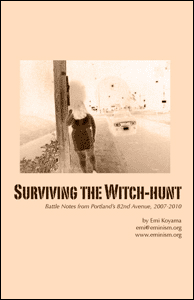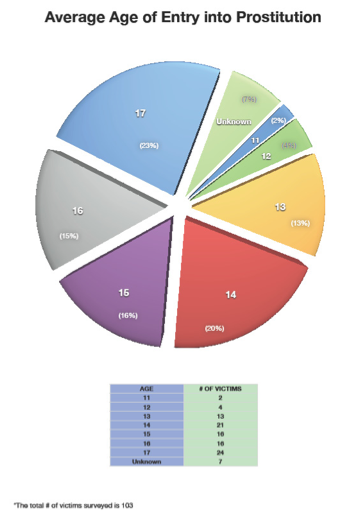While I was attending the Desiree Alliance conference in Las Vegas, there was a big news in Portland: YWCA of Greater Portland received a $900K federal grant to create a shelter for girls and women under the age of 18 who have been “trafficked” (and I put the word in quotation marks because the legal definition of “trafficking” makes no distinction between youth engaging in prostitution under force, coercion or deception, and those who do so without these factors–I think it’s a bad idea to conflate these very different cases).
But the more interesting news, reported by Portland Tribune, is that the City of Portland is now planning to fund a pilot program in which several women (of any age, it appears) leaving prostitution will receive financial and other support that will enable them to live independently in the community, rather than in a centralized transitional facility. Tribune reports:
The third effort under way is led by City Commissioner Dan Saltzman, who is working on a pilot program that would begin this fall. The program would place women seeking to escape their life on the street into private-market units around the city, rather than in one central “safe house.”
The nonprofit Join, which already works with the city’s housing efforts, uses a “housing-first” model that places people in housing and then gives them the social, financial and other support they need to maintain that housing. Join will provide the up-front rent and moving costs, work with the landlord and supply other help as needed.
[…]
If the woman relapses and returns to the street for a short time, she will not lose their housing, since that’s one of the philosophies of the housing-first model, says Amy Trieu, a policy coordinator for Saltzman: “The purpose is to build that trust.”
This is exactly the approach I along with others affiliated with Sex Workers Outreach Coalition (SWOC), a network of activists, sex workers, and social service providers, advocated for back in December 2009, when the 82nd Avenue Prostitution Advisory Committee (PAC) made its report to the City Council. The PAC had been set up by the Council a year earlier, and it largely represented the perspectives of the law enforcement, anti-prostitution activists, and area business owners, rather than the women and social service providers who outreach to them. Among other things, PAC recommended:
Allocate funds for in-patient rehabilitative services and addition of supportive housing directed to prostituted persons, both adult and minor ; PAC asks that City Council commits to help fund a housing program (includes external evaluation) in fiscal year 2011
The PAC wanted to create a “10 bed in-patient rehabilitative housing” with the FY2011 budget of $657-913K. In contrast, SWOC recommended “housing first” approach precisely as described by Tribune–and the City apparently agreed with us. Here’s that section from SWOC’s December 2009 recommendations:
Housing is often considered a primary need for women working in prostitution, and it is essential if we are to assist women who wish to leave the sex industry (or abusive pimp, partner, etc.). We support the use of housing first approach in collaboration with existing housing advocacy organizations.
Housing first, also known as rapid re-housing, is an innovation within homeless advocacy that seeks to quickly place recently or chronically homeless persons and families in their own permanent housing in the community instead of keeping them in centralized “transitional” housing that they must vacate after the program period. This eliminates the stigma of living in a shelter or transitional housing, provides the stability necessary to address personal issues, and builds sense of autonomy and independence.
Many homeless people experience multiple problems, such as mental illness, addiction, psychological trauma from abuse, and HIV/AIDS. Traditional service providers try to address these issues while they are in shelters or transitional housing, but their effectiveness is limited by the hardship of their living circumstances. Housing first model seeks to establish stability to people’s lives through housing, so that other issues can receive adequate attention once individuals are secure in their own place. Women in the process of leaving prostitution can also be supported by a combination of a housing first program and a series of other services arranged with the help of the caseworker.
Some people may find the idea of residential treatment centers, in which women can access support groups, case management, addiction treatment, etc. at the place they live, appealing. One advantage of such plan is that it offers built-in opportunities where women who have a history of prostitution can meet and support each other. But forcing them to live together and share living quarters at some centralized location in order to receive that support is likely to be a mistake. Without a private housing to go home to, participants would not feel inclined to take the risk and disclose personal stories and feelings among their peers.
In addition, women who drop out from the program for any number of reasons at a residential treatment facility would also lose their housing. Housing first approach gives women greater protection from this problem. If we believe that housing is a basic human right, we should not be threatening to withdraw it in order to coerce compliance with the treatment program. Nor should we need to, if the programs actually offer something that women benefit from.
Locally, homeless advocacy organizations such as Transition Projects Inc. as well as Volunteers of America’s domestic violence program (Home Free) incorporate some forms of housing first model as part of their respective programs. We should make use of their experiences and expertise in providing assistance with housing, as we develop specific services and resources for women who are in the process of leaving prostitution.
Over the last several years, we (at SWOC) have made numerous attempts to communicate with City Council members and explain why we must be included in the discussion about the City’s response to the issue of prostitution on our streets and in our neighborhoods, but we have been mostly ignored. But it appears that now the City is choosing the recommendation we made at the City Council over that of the City’s officially sanctioned (albeit misinformed) “advisory committee,” and it says a lot about the power of democratic deliberation even when things appear hopeless.


